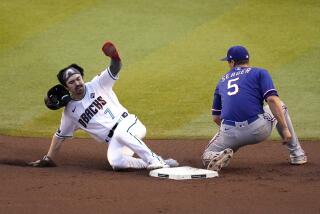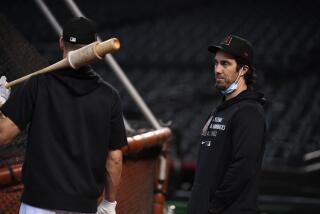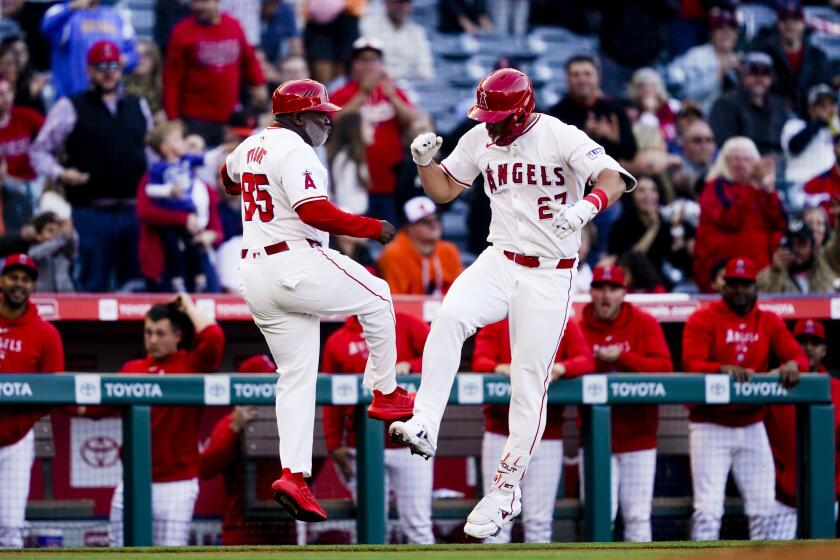Angels’ Jered Weaver has been more deceptive and dominant with pitches

Angels starting pitcher Jered Weaver has found success recently despite diminished fastball velocity.
There is one major league pitcher with at least 10 starts this season who throws a fastball that travels more slowly than that of Angels right-hander Jered Weaver.
That’s R.A. Dickey, and he’s a knuckleball specialist.
Yet, since Weaver returned this month from an injury, perhaps no major league pitcher has made hitters look as bad.
In his most recent start, against the Chicago White Sox, Weaver’s first strikeout came when slugger Jose Abreu flailed weakly at a breaking ball in the dirt.
And then: Avisail Garcia froze on an 82-mph fastball inside. Tyler Saladino waited and waited on a 63-mph breaking ball. He ended up on one knee; the pitch ended up in the catcher’s mitt. Both of Adam Eaton’s knees buckled as he stared at a 74-mph changeup. Alexei Ramirez swung on a 74-mph pitch that nosedived, as though it were a dead bird, at his back ankle.
“If he locates his stuff,” Angels reliever Joe Smith observed, “he makes guys look pretty foolish.”
Weaver’s season has been as much a moving target as his pitches. In April, radar-gun watchers wondered whether he was done. In May, he looked like the Weaver of his prime. In June, he imploded. Now, recovered from a hip injury that landed him on the disabled list, he is dominating hitters with a fastball that tops out in the low- to mid-80s.
As he approaches the final year of his contract, Weaver, 32, has shown that, though his shelf life is a mystery, how long he lasts won’t have much to do with his velocity.
Weaver, who will try to steady the slumping Angels on Tuesday against the Detroit Tigers, has a 2.08 earned-run average with 15 strikeouts and two walks in 17 1/3 innings over three starts since his return. His recent surge, he says, is a credit to his health.
In June, Weaver was dealing with inflammation in his hip that limited his mobility. Weaver’s unusual delivery, in which he throws across his body, helps him trick hitters. But with his hip acting up, he had to worry about landing just so on each pitch. He felt restricted, not loose as he normally does.
“With a lot of moving parts that I have, that’s very important for me,” Weaver said.
His command untethered, Weaver’s ERA in June mushroomed to 6.58. By the time he was scheduled to go against Oakland on June 20, Weaver had reached a critical point.
“That start against Oakland, I just couldn’t throw the ball the way I wanted to,” Weaver said. “I was just beating my head against the wall pretty much. It was like feeling naked. If you don’t have your location, especially if you’re not throwing 97, it’s not going to work out too good for you.”
He went on the disabled list with the goal of loosening and strengthening his hip. At the time, Weaver said that “there is more to it than just the hip stuff.” But pitching coach Mike Butcher was of the opinion that Weaver’s problems all branched from the injury.
To get it right, a massage therapist worked on loosening the muscle and the training staff put Weaver through strength exercises and stretches.
When the hip’s flexibility returned, so did Weaver’s command — and his deception.
After Weaver’s 6 1/3 shutout innings last Wednesday against the White Sox, Smith and others marveled that Weaver could freeze major league hitters with a fastball in the 80s.
Weaver does it with a two-seam fastball that curls back from a left-handed hitter’s hip to the inside part of the zone. A slider, which looks identical out of the hand, plunges the opposite way, toward the back foot.
“Lefties have to definitely make a decision on the inner half of the plate, whether it’s going to be a four-seamer, slider, changeup or two-seam running back over,” catcher Chris Iannetta said.
Many of those pitches end up well out of the strike zone. But not the two-seam fastball. “That’s what freezes them,” even if the pitch is in the low-80s, Iannetta said.
“It serves to show you,” Butcher said, “this game’s all about command. It’s not about velocity.”
Manager Mike Scioscia said there is a minimum velocity that each pitcher needs to be effective. Weaver has not gotten there. Jerry Weinstein, an assistant coach for the Colorado Rockies, tweeted recently that as Weaver’s fastball has dropped, he has actually grown more inscrutable by dropping the velocity on his other pitches even further.
That difference amounts to what people around the game refer to as the distinction between “throwing” and “pitching.”
“People think you have to be able to throw 95 to be able to throw fastballs these days,” closer Huston Street said. “The game was around for 100 years with the average fastball velocity being below 90. To me, if you can locate and get ahead, locate and get ahead, that to me is how you can really dominate.”
For now, Weaver is back to locating.
Before a recent game, Weaver walked slowly toward his locker, bebopping to the beat throbbing from his headphones. He is the second-highest paid player in that clubhouse, behind only Albert Pujols. Weaver will make $20 million in 2016 and then can become a free agent.
Is he pitching for another contract? He preferred not to talk about that.
He preferred, too, not to think about those that pronounced him washed up at the beginning of the season.
“I just go out there and pitch, man,” he said.
Up next
Weaver (5-9, 4.34 ERA) will oppose Detroit Tigers right-hander Alfredo Simon (11-7, 4.52) at Comerica Park on Tuesday at 4 PDT. TV: FS West; Radio: 830, 1220.
More to Read
Go beyond the scoreboard
Get the latest on L.A.'s teams in the daily Sports Report newsletter.
You may occasionally receive promotional content from the Los Angeles Times.







